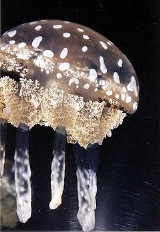
Spotted jelly
Encyclopedia
The Spotted Jelly or Lagoon Jelly (Mastigias papua) is a species of jellyfish
. It lives mainly in the southern Pacific Ocean
. Instead of one single mouth, they appear to have several smaller mouth openings in their oral arm
s. These feed on zooplankton
.
In Japan--especially along Pacific coast areas--these are sold as novelty pets, along with photoautotrophic phytoplankton
, and are called takokurage (タコクラゲ), or "octopod" or "rammer" jellies.
They seem to have a lifespan of approximately 4 months and are active primarily in mid-summer to early-fall.
Jellyfish
Jellyfish are free-swimming members of the phylum Cnidaria. Medusa is another word for jellyfish, and refers to any free-swimming jellyfish stages in the phylum Cnidaria...
. It lives mainly in the southern Pacific Ocean
Pacific Ocean
The Pacific Ocean is the largest of the Earth's oceanic divisions. It extends from the Arctic in the north to the Southern Ocean in the south, bounded by Asia and Australia in the west, and the Americas in the east.At 165.2 million square kilometres in area, this largest division of the World...
. Instead of one single mouth, they appear to have several smaller mouth openings in their oral arm
Oral arm
An Oral arm is an anatomical structure of "true" sea jellies , which belong to the class Scyphozoa. Oral arms characterize Semaeostomeae, an order of large jellyfish....
s. These feed on zooplankton
Zooplankton
Zooplankton are heterotrophic plankton. Plankton are organisms drifting in oceans, seas, and bodies of fresh water. The word "zooplankton" is derived from the Greek zoon , meaning "animal", and , meaning "wanderer" or "drifter"...
.
In Japan--especially along Pacific coast areas--these are sold as novelty pets, along with photoautotrophic phytoplankton
Phytoplankton
Phytoplankton are the autotrophic component of the plankton community. The name comes from the Greek words φυτόν , meaning "plant", and πλαγκτός , meaning "wanderer" or "drifter". Most phytoplankton are too small to be individually seen with the unaided eye...
, and are called takokurage (タコクラゲ), or "octopod" or "rammer" jellies.
They seem to have a lifespan of approximately 4 months and are active primarily in mid-summer to early-fall.

